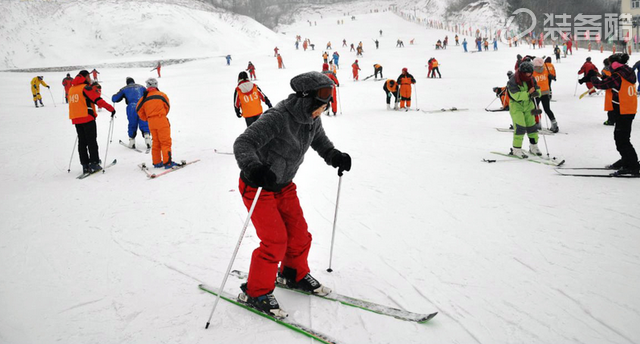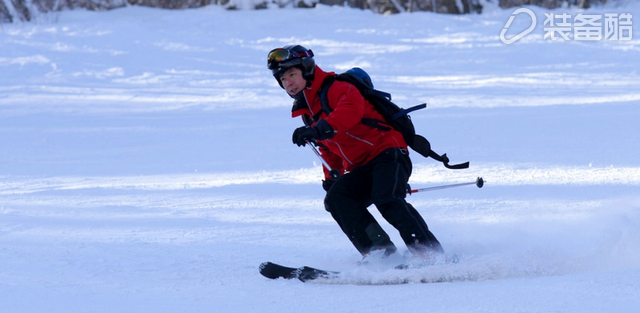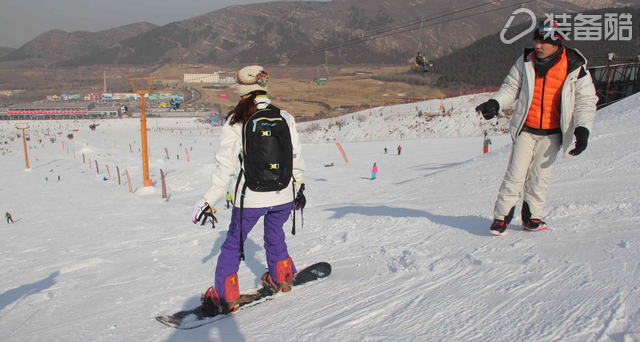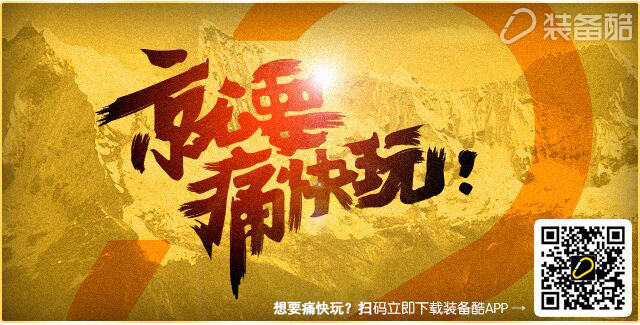Just beginning to learn to ski, everyone will inevitably not adapt, the body is not relaxed enough, the point is not right, the action is not as skilled as the coach. Therefore, it is normal to have some small technical problems. How should these problems be discovered and corrected? Follow the description of Xiaobian to learn how to improve it.

"Looking in the direction of the line of sight"
Feeling: Your feeling should be - see far, speed is not terrible.
Description: Eyes on the tip of the board, the first mistake a beginner must make on the snow! The distance between the line of sight and the ground is as far as possible, and the line of sight will be broad and safe. Is it like driving a turn and you're staring at the steering wheel? Before playing basketball, look down to see where the ball is. The eyes should look in the direction you go. Don't pay attention to the snowboard under your feet!
"The center of gravity is behind"
Feeling: If you feel the pressure on the lower leg of the shoe is behind the lower leg, then the center of gravity lags behind; the mid-level snow friend is long-distance thigh acid; the upper class snow friend is out of control and difficult to turn after being wrapped.
Description: The most common problem, if you do not know what is the correct skiing posture, please calibrate with your partner first. Through slanting downhill, crossing the ski slopes, and gliding through small and medium hops to feel, especially jumps, if you can make a continuous small jump throughout the turn, basically the center of gravity is correct. The middle and senior Xueyou focus is achieved through pressure control. Crossing the mushroom road is a good practice method.
The conventional explanation for the center of gravity is fear. The first and second gliding may be fearful. But after a few times, the fear is not so important (maybe there will be a little, but it will not be the main reason). The real reason is that we have never They are all standing upright, suddenly letting you stand at a slant, the cerebellum will think it is dangerous and coordinate the body not to do it. This can't be done without realizing the feeling that "the body can still be well controlled even if it is tilted". It can only be achieved by one's own efforts. This is one of the reasons why you should not go too fast on the senior road. Senior Road will give you a rare opportunity to experience the feeling of “good control†and thus develop bad habits. It is difficult to change habits once they are cultivated. More simple ski experience, and gradually increase the difficulty.
"Rear Seat"
Feeling: primary, out of the bend and press down, feeling deceleration; mid-level, out of the corner when the board is converted to take the run; senior, there is a sense of burling every turn, not continuous; subjectively feeling to be hale.
Description: The difference between the rear seat and the center of gravity is that the rear seat knees are bent too much, the ankles are not bent enough or are not bent (front and back). Sometimes the center of gravity may not lag, but it looks a bit ass licking, also called licking. Occurred in a certain carbene experience can find a feeling of overweight, but the knee is bent too much, the buttocks behind the heel, easily fatigued, and not look good.
On the steep slope, it can be decelerated through the rear seat and the effect is good, but this is the primary speed control. The main problem caused by the back seat is not smooth, and the deceleration is controlled through the curved shape as much as possible. It doesn’t matter how many degrees the snowboard turns into a round shape. The key is that the rotation of the snowboard is from beginning to end. Looking back at the traces on the ground, the traces of your snowboard snow sweeping (snow twisting) are of equal width. It is not narrow at 3/9 and 6/12. It should be a width from beginning to end. Say a trick to hold a master's thigh, if the noodles snow in the morning to see someone slide out the width of the width, hold the thigh! The warm-up circle can still draw the traces of constant width by finding the feeling of snowfall. It is definitely a true master, and it is very likely to be a top master. Next, it depends on your facial expression. . .

"The upper body has a turn and the arm swings."
Feeling: I always feel that my turn is not over. I may turn my head in an urgency. Snowboards are often not parallel. It is more difficult to stop in an instant. I have to be ready in advance to make a turn.
Description: For beginners to ski, often using the body to drive a turn, it feels easier. But in fact, turning with the thighs will be more stable and more efficient. The practice method is continuous Garland on the slope, rotating horizontal slide, two-handed abutment, two-handed staff window sliding. The upper body belt rotation is almost always a zigzag pattern, and is often accompanied by left and right brake deceleration. If your head and body are always sideways and do not face downwards (roll off the line) when you are taxiing, you should consider Whether the body has taken a turn.
"Right brake"
Feeling: It takes a long distance to slow down, the snowboard shakes, the ground gives you feedback when it's big and small, and it's crazy to meet uneven ground.
Description: As observed in the cable car, it is likely that more than half of intermediate snowboarders will glide in this manner, especially on steeper snow pressure roads. Comparing your own number of turns and the number of turns that people look at when they look better, if the speed is almost the same but the number of bends is a lot worse, it's likely that you are using brake-type taxiing. You may feel that the brake gliding is similar to the gliding gliding, but the rotational traverse is very demanding and the technique is not the same and cannot be confused.
The reason for the brake-type taxiing is likely to be on a ski trail that exceeds its own ability. Tension requires speed control and this defensive sliding method is used. The problem of brake gliding is that the control is poor. Once the snow is uneven, smooth or fast, it is easy to get out of control. Get rid of the brake-slip method, practice basic parallelism, slide a very round bend in the primary road, feel good and then go to the middle road to draw a round bend.
"Position of cane"
Feelings: I only knew when I saw the hand - the position of the cane was wrong again; the senior Xueyou only watched the video and found that the cane was not quite the same as the idea.
Description: If you don't care about walking sticks, don't just mention it. Even the middle and senior snow friends are very helpful when they do not practice with sticks. The best way to practice at the primary level is to imagine that the tip of the pole is on the ground 10 to 20 cm outside the feet of both feet. If the length of the pole is appropriate, the stance is almost correct. At the same time, mopping the tip of the stick increases confidence. Sliding at high speed and dragging the double sticks at the same time will confirm the upper body level. In general, a stable upper body can realize whether the walking stick is tampered or not. The position of the good walking stick is not beautiful, but you can always confirm the position of the tip of the stick.

"Down hill"
Feeling: If your downhill hill is pointed out many times, it's still not clear. Only watching your own video will give you a slight feeling.
Description: Simply put, it is the angle of the body's rolling line. If you don't take the initiative to plunge down the hill if you go out of the corner, it is easy to cause a fall.
"Inner board bearing"
Feeling: The inner side of the taxi cannot be lifted off the ground. Even if the subject wants to lift, it cannot be lifted. When the skis face the fall line (high speed), the inner side is still under more pressure.
Description: First of all, the weight of the outer blade of the inner plate is not wrong. The double plate originally has two blades. How to use it flexibly is the key. But in most taxis, especially high-speed taxiing, more weight will be more stable on the outer edge of the outer plate, and the faster the speed, the more the outer plate needs to bear more weight. The low speed inner board must bear weight, otherwise it will be unstable. Because no beginners have the ability to balance independently on the blade, standing between the two feet is ideal and safe. As the speed gets faster and faster, the center of gravity is gradually shifted to the outer plate, and the pressure is turned continuously through the outer plate. Failure to release the inner panel pressure will have an impact on future advancement. The weight of the inner plate may cause the following problems: K-leg, V-shaped plate, excessive spacing of the two plates, excessive forward of the inner plate head, zigzag bend, etc.
"K leg"
Feeling: If the inner foot doesn't move forward and the knee doesn't move sideways, it's easy to form K-legs.
Description: As long as the K-leg is not formed by the inner plate, the other parts can be ignored as long as they are not particularly serious. There may be reasons for physical reasons, equipment reasons, Alignment problems, and habits. Keeping the distance between the knee and the double board is the same as that of the body actively falling down the hill. It does not belong to the normal movement of the human body and may take a long time to correct. When you can stand with a high-angle edge, free distribution of pressure on your legs, and high-speed carbene, you may understand that the angles of the two-plate edged blades will be very awkward. It will be easy to solve the K-legged and A-legged problems at that time. In the initial and intermediate stages, the fact that the legs are slightly non-parallel is not a big problem. There are subjective conscious initiatives to close the feet and move the knees.

Manual Juicer,Meat Hammer,Manual Meat Chopper,Paring Set,Tenderlizer
Shangwey Cookware Co.,Ltd of Jiangmen City , https://www.shangwey.com